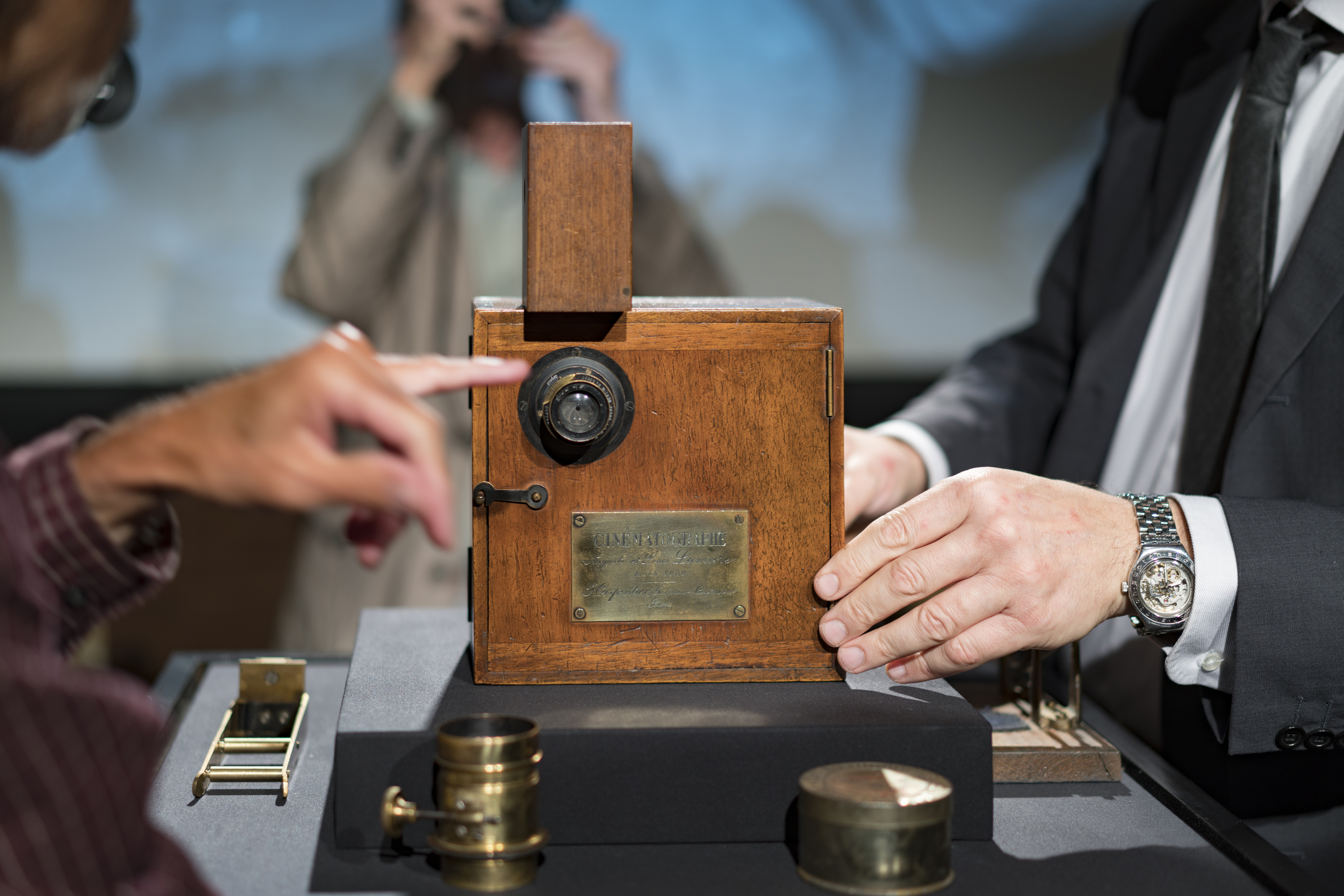
Lumière Cinématographe Comes to the ASC
The camera, serial number 31 (of 425 cameras manufactured by the Lumière brothers), is a wonder of engineering.

This week, the ASC Clubhouse was the site of an auspicious unveiling: an 1896 Lumière Cinématographe was presented to the ASC by Laurent Mannoni of the Cinémathèque Française. The camera, serial number 31 (of 425 cameras manufactured by the Lumière brothers), is a wonder of engineering. Made of wood, with brass fittings, and weighing 16 pounds, it is a camera, a projector and a printer all in one.
The Cinématographe will be housed at the Clubhouse on long-term loan from the Cinémathèque as part of a cultural exchange facilitated by Technicolor, which recently placed an original Technicolor 3-strip camera (model D26) at the Cinémathèque in Paris. The camera exchange was originated by ASC members Fred Goodich and Richard Edlund, and was coordinated by ASC associate member Bob Hoffman, vice president of marketing and public relations for Technicolor.
Mannoni, whose title at the Cinémathèque is Directeur Scientifique du Patrimoine et du Conservatoire des Techniques, is a renowned archivist, author and passionate scientific scholar. In presenting the camera, he addressed a large gathering of ASC members, as well as some emerging cinematographers who were attending this week’s ASC Master Class. “This camera, and what it symbolizes, is something so core to everyone in this room,” said ASC President Richard Crudo. “We all connect to it on a nearly spiritual level.”
The patent for the Lumière device was registered in France on Feb. 13, 1895. It was not christened "the Cinématographe" until May of that year. A switch in lenses and magazines opened up one of the camera’s three functions. Film development was simple: a bucket of developing fluid and a bucket of fixative. Reels were only 20 meters long at the time.
On Dec. 29, 1895, the first public performance (with an admission fee) was held in the Salon Indien at the Grand Café, near the Paris Opera. It was a great success.
The camera’s history is the stuff of legend. “The name Cinématographe was coined from the Greek for ‘writing in movement,’” Mannoni explained in his remarks. “It was manufactured at the start of 1896 by Jules Carpentier, a highly talented engineer who worked in Paris under instructions from Louis Lumière, even though Lumière's photographic plate, film and emulsion factories were located 300 miles away in Lyon. It remains an excellent camera that is light and strong and still works today.
“Louis Lumière’s interest in moving images arose in 1894, when he was able to view the Edison Kinetoscope, which was on public display in Paris,” Mannoni continued. “He was also familiar with the work of Etienne-Jules Marey, who as early as 1889 had started producing pictures on Eastman 90mm film. The film Marey used was not perforated and was so tricky to project. Lumière was more interested in using Edison Kinetoscope film stock. This is why, in early 1895, he designed a machine that could shoot moving pictures as well as project them. The film he used was the same gauge as Edison 35mm film, but perforated differently, with one round hole on either side of the frame.
“By 1897, though, Lumière 35mm film, with its two round perfs [on either end of frame], had fallen out of fashion. Edison's film had established itself almost everywhere as a market standard. So, Louis Lumière started selling cameras capable of using Edison film. Then, in 1904, overtaken by the rest of the industry, he withdrew from the fray.”
Mannoni’s expertise in the pre-history of cinematography was amply demonstrated in his book The Great Art of Light and Shadow: Archaeology of the Cinema, published in English in 2000 by the University of Exeter Press. The book explores early technological innovation that led to the advent of motion pictures, and includes a comprehensive study of the European obsession for Magic Lanterns, of which the Cinémathèque owns one of the world’s great collections.
The Cinémathèque Française was set up in 1936 as a private trust by founder Henri Langlois, who received an honorary Academy Award in 1974 for his services to European and American film conservation. The Cinémathèque set up a “Conservatoire of Cinematographic Techniques,” which owns a unique collection of ancient and modern equipment, some 6,000 pieces in all, going back to the earliest days of image making.
At this week's event, Mannoni shared with the ASC that the Cinémathèque is “planning a major exhibit on the history of cinematographic techniques” for October 2016. “Of course, our new Technicolor camera will occupy a place of honor in that show,” he said. “And you are all invited.”
Special thanks to Bob Hoffman.






